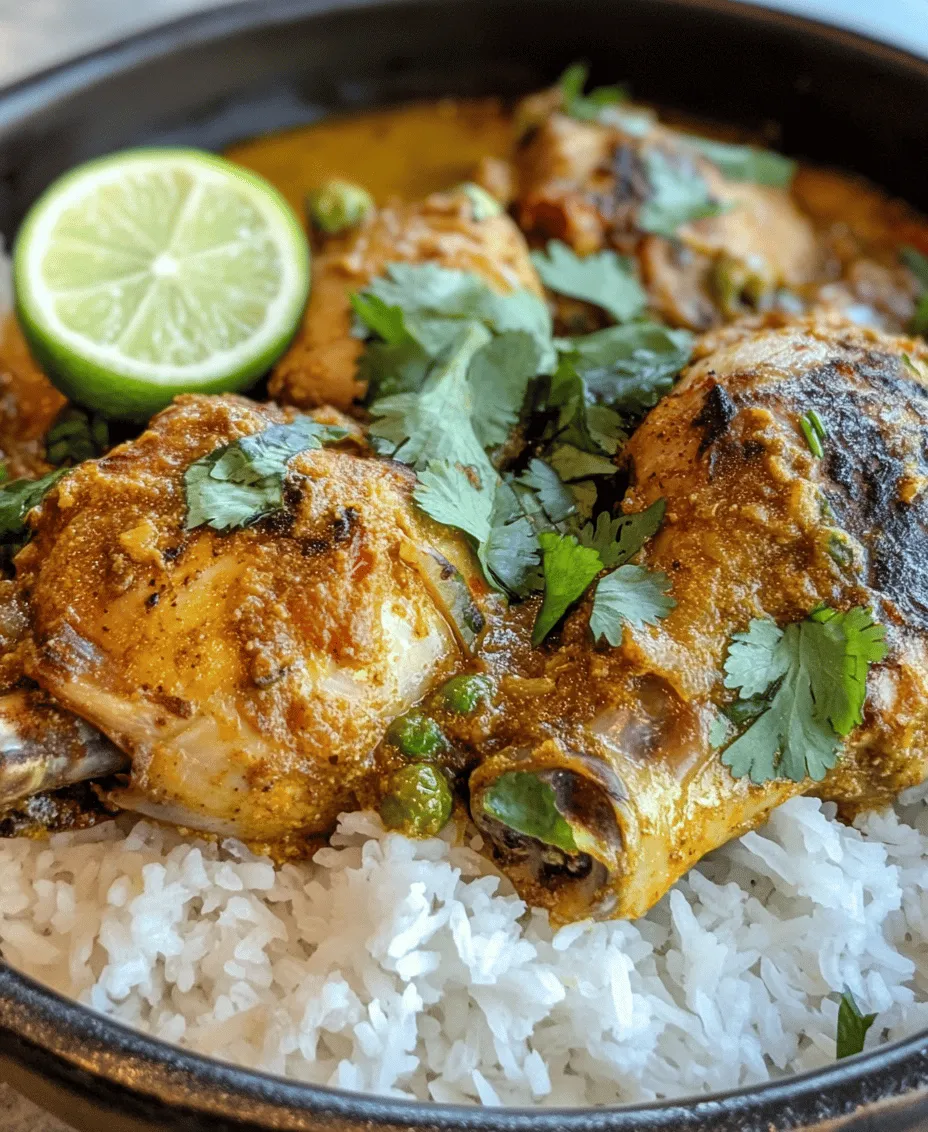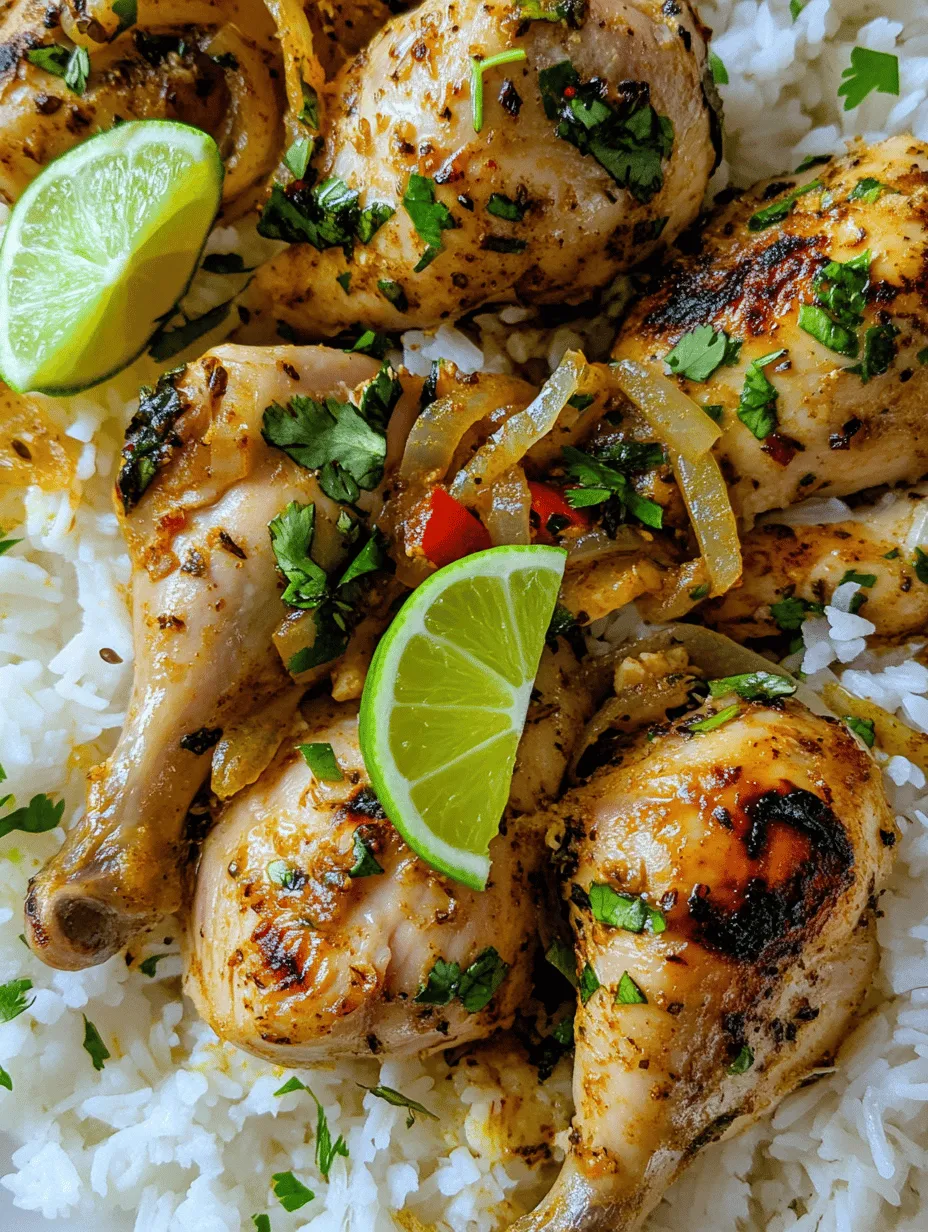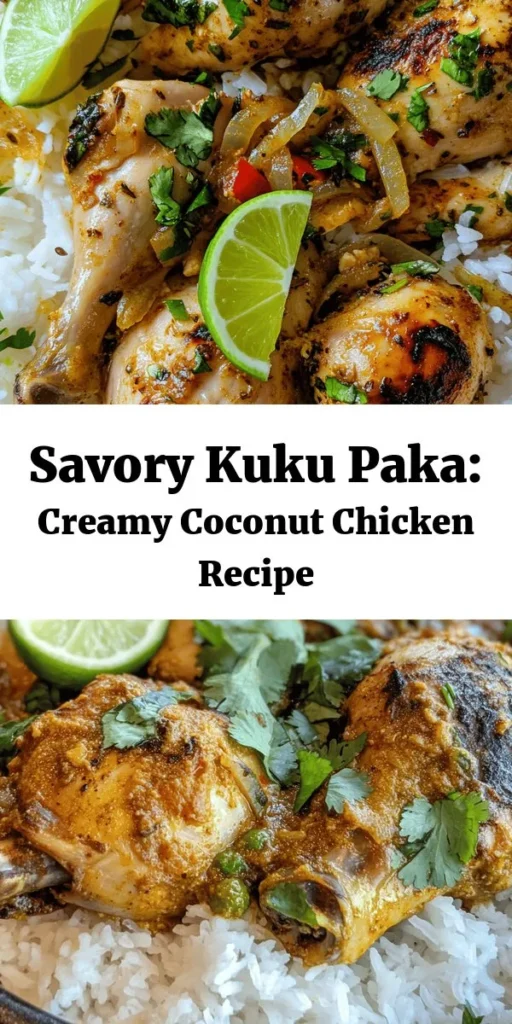Introduction
Kuku Paka is a delectable dish hailing from the coastal regions of East Africa, particularly popular in Kenya and Tanzania. This chicken delight is celebrated not just for its rich, creamy texture but also for its vibrant blend of spices and the unique flavor profile that coconut milk brings to the table. In a culinary landscape often characterized by its diverse influences, Kuku Paka stands out as a perfect example of how different cultural elements can harmoniously blend to create something extraordinary.
At its core, Kuku Paka is more than just a meal; it embodies the essence of East African cuisine, where spices, herbs, and fresh ingredients come together to create rich flavors and unforgettable experiences. The dish is often enjoyed at family gatherings, celebrations, and various cultural events, making it a staple in many households. Its popularity has transcended borders, and Kuku Paka can be found in restaurants and homes across the globe, appealing to those who appreciate the fusion of sweet and savory, creamy and spicy.
Understanding Kuku Paka
Historical Background of Kuku Paka
The origins of Kuku Paka can be traced back to the Swahili coast, where the interaction between local communities and traders from the Middle East and India brought about a culinary fusion that significantly influenced the region’s cuisine. The use of coconut milk in cooking is a tradition that is deeply rooted in coastal communities, where coconuts are abundant. The name “Paka” means to coat or smear in Swahili, which aptly describes the method of preparing this dish by enveloping the chicken in a rich coconut sauce.
Kuku Paka is believed to have evolved from traditional recipes that feature chicken cooked in various sauces, incorporating different regional spices and ingredients. The dish is a testament to the adaptability of East African cuisine, as it continues to evolve while staying true to its roots.
Cultural Significance in East African Households
In East African households, Kuku Paka is more than just a meal; it represents togetherness and the nurturing spirit of family. It is often served during special occasions, gatherings, and festivities, showcasing the warmth of East African hospitality. As families come together to enjoy this dish, it fosters a sense of community and connection, making it an integral part of cultural celebrations.
Moreover, Kuku Paka serves as a canvas for culinary creativity, allowing cooks to experiment with flavors and ingredients based on personal and regional preferences. This adaptability has led to numerous variations of the dish, each with its own unique twist while maintaining the core elements that define Kuku Paka.
Variations of Kuku Paka Across Different Regions
While the traditional recipe remains beloved, Kuku Paka has inspired numerous variations across different regions. In some areas, for instance, chefs may incorporate additional vegetables such as bell peppers or spinach to enhance the dish’s nutritional profile and add color. Others may experiment with the level of spice, adjusting the heat to suit local palates or individual preferences.
In Zanzibar, Kuku Paka may take on a slightly different flavor profile, incorporating spices such as cardamom or cloves, which are prevalent in the region’s cooking. On the other hand, in mainland Kenya, you may find recipes that emphasize a more robust use of garlic and ginger, offering a deeper flavor experience. Despite these variations, the essence of Kuku Paka—its creamy coconut sauce and fragrant spices—remains a constant, making it a beloved dish across the East African culinary landscape.
Ingredients Breakdown
To prepare Kuku Paka, it is essential to understand the main ingredients and their roles in creating this delightful dish. Each component contributes to the overall flavor and texture, resulting in a culinary experience that is both satisfying and memorable.
Chicken: Protein Source and Main Component
At the heart of Kuku Paka is chicken, which serves as the primary protein source. The choice of chicken is crucial, as it absorbs the flavors of the spices and coconut milk beautifully. You can opt for bone-in, skin-on chicken pieces for a juicier result, or use boneless chicken thighs for quicker cooking. The marinating process is vital, as it allows the chicken to soak up the spices, setting the stage for a flavor-packed dish.
Coconut Milk: Adds Creaminess and Flavor Depth
Coconut milk is the star ingredient that sets Kuku Paka apart from other chicken dishes. It provides a rich, creamy texture that balances the spices and enhances the overall flavor profile. The natural sweetness of coconut milk complements the savory elements of the dish, resulting in a delightful contrast that keeps diners coming back for more. When selecting coconut milk, opt for high-quality, full-fat versions for the best results.
Spices: Importance of Garlic, Ginger, and Various Spices
The depth of flavor in Kuku Paka comes from a harmonious blend of spices. Garlic and ginger are foundational, providing aromatic notes that elevate the dish. Other common spices include cumin, coriander, turmeric, and sometimes even a hint of chili for those who enjoy a bit of heat. This mix not only enhances the flavor but also contributes to the dish’s fragrant aroma, making it irresistible.
Fresh Ingredients: The Role of Cilantro and Lime Juice
Fresh herbs and aromatics play a significant role in brightening the dish. Cilantro is often used as a garnish, adding a burst of freshness that complements the richness of the coconut milk. Additionally, a squeeze of lime juice just before serving can elevate the flavors, providing a tangy contrast that balances the dish beautifully.
Tips on Sourcing Authentic Ingredients
To achieve an authentic Kuku Paka, sourcing high-quality ingredients is essential. Visit local markets or specialty stores for fresh spices and coconut milk. When possible, choose organic or sustainably sourced chicken to enhance the dish’s flavor and quality. Fresh cilantro and limes should be vibrant and aromatic, ensuring they add the desired brightness to your dish.
Preparation of Kuku Paka
Now that we have a clear understanding of the ingredients, let’s dive into the preparation of Kuku Paka. The process involves several key steps, each designed to build layers of flavor and achieve the perfect texture.
Step-by-Step Guide to Marinating the Chicken
The first step in preparing Kuku Paka is marinating the chicken. This is a crucial phase that allows the flavors to penetrate the meat, resulting in a tender and flavorful dish. Begin by combining minced garlic, grated ginger, and your choice of spices in a bowl. Add a bit of salt and pepper to taste, and mix well.
Next, coat the chicken pieces evenly with the marinade, ensuring that every piece is well covered. Ideally, let the chicken marinate for at least 30 minutes; however, for best results, marinating it overnight in the refrigerator will yield the most flavorful outcome.
Importance of Marination for Flavor Enhancement
Marinating is more than just a step in the cooking process; it is an essential technique that enhances the overall flavor of the dish. The longer the chicken sits in the marinade, the more it absorbs the spices, resulting in a rich and complex flavor profile. This is particularly important for Kuku Paka, where the balance of spices and creaminess is key to creating a delicious final dish.
Sautéing the Base Ingredients
Once your chicken is marinated, it’s time to sauté the base ingredients. Begin by heating a generous amount of oil in a large skillet or pot over medium heat. Traditional recipes often use vegetable oil or coconut oil for an authentic flavor.
Add finely chopped onions to the pan, allowing them to soften and become translucent. This step is crucial, as the onions form the aromatic base of the dish. Stir occasionally to prevent burning, and cook until the onions are golden brown to develop a deeper flavor.
Techniques for Achieving the Perfect Onion Sauté
To achieve the perfect onion sauté, patience is key. Avoid rushing this step; allowing the onions to caramelize enhances their sweetness and contributes to the overall depth of flavor in the dish. You may choose to add a pinch of salt to help draw out moisture, which can facilitate the cooking process.
Once the onions are golden and fragrant, it’s time to add the marinated chicken to the skillet. Be sure to scrape any bits stuck to the bottom of the pan, as these caramelized bits will add even more flavor to your Kuku Paka.
Incorporating the Chicken into the Cooking Process
Carefully add the marinated chicken to the skillet, ensuring it is spread out in a single layer for even cooking. Allow the chicken to sear for a few minutes without stirring, enabling a delicious crust to form. After a few minutes, stir the chicken to ensure it cooks evenly on all sides.
As the chicken begins to brown, you can introduce coconut milk to create the creamy sauce that Kuku Paka is known for. The chicken should simmer gently in the coconut milk, allowing the flavors to meld beautifully.
With these steps, you are well on your way to creating a flavorful Kuku Paka that will surely delight your family and friends. Stay tuned as we explore more about the cooking techniques and serving suggestions in the next part of this recipe article.

Tips for Browning Chicken Effectively
Browning chicken is a crucial step in achieving a rich flavor profile in Kuku Paka. Here are some expert tips to ensure your chicken is perfectly browned:
1. Pat the Chicken Dry: Before cooking, use paper towels to pat the chicken pieces dry. This helps achieve a better sear as moisture on the surface can steam the chicken instead of browning it.
2. Use the Right Oil: Select oils with a high smoke point, such as vegetable oil or coconut oil, to prevent burning and to create a nice crust.
3. Don’t Overcrowd the Pan: Cook the chicken in batches if necessary. Overcrowding leads to steaming rather than browning, which can prevent that deep flavor development.
4. Let it Sizzle: Once you place the chicken in the pan, avoid moving it around for a few minutes. This allows the chicken to develop a golden crust. Flip only when it easily releases from the pan.
5. Control the Heat: Start with high heat to achieve a good sear, then adjust to medium to ensure the chicken cooks through without burning.
Building the Flavor Profile
The Significance of Coconut Milk in Balancing Spices
Coconut milk is the star ingredient in Kuku Paka, providing a creamy richness that balances the spices beautifully. Its natural sweetness complements the heat from chilies and the earthiness of spices like cumin and coriander. The fat content of coconut milk helps dissolve and meld these flavors, ensuring a harmonious blend in every bite.
How Chicken Broth or Water Complements the Dish
While coconut milk is essential, adding chicken broth or water is equally important for achieving the right consistency. This addition helps thin out the sauce while infusing more savory depth into the dish. The broth enhances the umami profile, making each spoonful more satisfying.
The Role of Green Chilies in Adding Heat and Flavor
Green chilies are a key flavor element in Kuku Paka. They not only add heat but also a distinct freshness that lifts the overall dish. Adjust the quantity based on your heat tolerance; for a milder version, remove the seeds or use fewer chilies.
The Importance of Simmering for Flavor Integration
Simmering is crucial for the integration of flavors. Once the chicken is added to the coconut sauce, allow it to simmer gently. This process enables the chicken to absorb the spices and the coconut milk to thicken, resulting in a rich, flavorful sauce. Aim for a simmer time of at least 30 minutes to allow the flavors to meld beautifully.
Cooking Techniques and Best Practices
Overview of Cooking Methods Suitable for Kuku Paka
Kuku Paka can be prepared using various cooking methods, including stovetop, slow cooking, or even pressure cooking. Each method has its benefits:
– Stovetop: Ideal for achieving a quick sear and controlling the simmering process.
– Slow Cooking: Perfect for busy days, this method allows the flavors to develop over several hours.
– Pressure Cooking: A great way to achieve tender chicken in a fraction of the time while still allowing the spices to infuse.
Importance of Simmering and How It Affects the Dish
The simmering process is essential in Kuku Paka. It allows the chicken to cook through while the spices blend harmoniously with the coconut milk. This slow cooking method also ensures that the chicken remains tender and juicy, preventing it from drying out. Always keep the lid on while simmering to retain moisture and enhance flavor absorption.
Adjusting Seasoning and Flavors Towards the End of Cooking
Taste your Kuku Paka before serving. This is the time to adjust the seasoning. If you desire more heat, consider adding a pinch of cayenne pepper or a bit more chopped green chilies. For added depth, a splash of lime juice or a dash of soy sauce can enhance the overall flavor.
Serving Suggestions
Best Practices for Serving Kuku Paka
When it comes to serving Kuku Paka, presentation plays a crucial role. Serve it hot in a large bowl or on a platter, allowing guests to help themselves. Garnish with fresh cilantro or parsley for a pop of color and freshness. This simple touch elevates the dish aesthetically and adds a refreshing herbal note.
Ideal Accompaniments: Rice vs. Flatbreads
Kuku Paka pairs beautifully with both rice and flatbreads, allowing for versatility depending on preferences.
– Rice: Fluffy jasmine or basmati rice is ideal for soaking up the rich coconut sauce, balancing the dish’s flavors.
– Flatbreads: Soft chapatis or naan are perfect for mopping up the sauce, adding a delightful texture contrast.
Consider serving a side of sautéed vegetables or a light salad to complement the dish. This adds freshness and balances the richness of the coconut sauce.
Presentation Tips to Enhance Visual Appeal
To enhance the visual appeal of your Kuku Paka, consider using colorful garnishes. A sprinkle of chopped green herbs or a few slices of lime can add vibrancy. Serve the dish in a beautiful ceramic bowl or platter to create an inviting atmosphere. The sight of a steaming bowl of Kuku Paka, surrounded by rice or flatbreads, is sure to entice any guest.
Nutritional Information
Overview of the Nutritional Benefits of Kuku Paka
Kuku Paka is not only delicious but also offers various nutritional benefits. The main ingredients contribute to a well-rounded meal rich in protein, healthy fats, and essential vitamins.
– Chicken: A great source of lean protein, chicken helps in muscle repair and growth.
– Coconut Milk: Packed with medium-chain triglycerides (MCTs), coconut milk can provide energy and support metabolism. It’s also rich in vitamins C, E, and B vitamins.
– Spices: The spices used in Kuku Paka, such as turmeric and cumin, offer anti-inflammatory properties and antioxidants.
Discussion of Macros Per Serving
A standard serving of Kuku Paka (about one cup) contains approximately:
– Calories: 350-400
– Protein: 25-30g
– Fats: 20-25g (mostly from coconut milk)
– Carbohydrates: 10-15g
These macros can vary based on portion sizes and specific ingredient choices.
Health Benefits Associated with Coconut Milk and Spices
Coconut milk is known for its potential heart health benefits, including improving lipid profiles and lowering cholesterol levels. The spices commonly used in Kuku Paka, such as turmeric, are celebrated for their anti-inflammatory properties and potential benefits in managing chronic diseases. Combined, these ingredients create a dish that is not only flavorful but also nourishing.
Conclusion
In conclusion, making Kuku Paka is a culinary journey that takes you deep into the heart of East African cuisine. From the initial browning of the chicken to the final simmering of spices and coconut milk, each step contributes to a dish that is both comforting and full of flavor.
The versatility of Kuku Paka allows it to shine on any dining table, whether as a weeknight dinner or a special occasion feast. Its rich history and connection to East African culture make it a dish worth exploring and sharing.
Embrace the vibrant flavors and textures of Kuku Paka, and let it inspire you to delve deeper into the world of East African cooking. Enjoy the process and the delightful outcome of this aromatic dish—it’s sure to become a cherished recipe in your kitchen.



